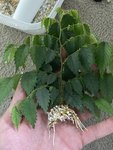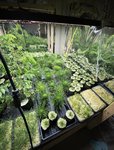First, relax, there are many beautiful gardens in Savannah Georgia, they are not full of dead and dying plants. JBP, Chinese elms, and junipers are not very sensitive to pH at all, so if you are having pH problems the Satsuki Azalea, and Japanese maples should have shown much more serious symptoms long before the JBP and junipers would show any symptoms. Seriously I would be looking for a different source of your problems because where pH is concerned, not all plants are equal, you should have had strong response from azalea, and no response from elm, JBP and juniper. Something else is going on.
One fact that comes into play is, all plants are capable of buffering the water film around their roots into the proper pH range to absorb nutrients. For example, Paph orchids growing on bare limestone rock in Java, the rain water running off the adjacent rock had a pH around 7.5, the water film surrounding the root of the plant attached to the rock had a pH of about 5.8 The result of the test was proof the plant was actively secreting buffers to modify the environment around the root zone, the film of water around the roots, into the ideal pH range.. The plants can modify their environments.
The above means pH alone is not a useful measurement. You need to dig further into your water chemistry to make sense of pH. All municipal water is buffered to pH 7.8 to 8.5 as required by law. This is to avoid leaching lead into the water system, poisoning us in the exact same way Flint Michigan poisoned its residents.
The measurement that is of value is the TOTAL ALKALINITY of your water. This is the measurement of the buffer capacity of your water. Total Alkalinity is expressed as milligrams of calcium carbonate per liter of water. mg/l. It is a measurement of ionic salts dissolved in the water. For anyone getting their water from the Great Lakes, most surface rivers or reservoirs, and wells in granite based bedrock, total alkalinity is low to moderate, meaning no matter the pH of the water, plants need to excrete very little to buffer the film of water surrounding their roots into the ideal range to absorb nutrients. People who get their water from wells, where the ground water is coming from limestone bedrock layers are the main group of people dealing with high total alkalinity water. For them, the total alkalinity will be a problem. It is possible to overwhelm a plant's ability to buffer its environment. This is why alkali salt flats have a unique and limited list of plant species that thrive there.
Total alkalinity is often reported in the annual water report most municipalities issue every year. It is a relatively simple test to run in a chem lab, the technique has not changed since the early 19th century. For about $40 an independent soil testing or water testing lab can run it on your water.
For 95% of North America, the water chemistry is pretty similar, and TOTAL DISSOLVED SOLIDS, TDS, can be used to approximate Total Alkalinity. It is not an exact relationship, and there are moderately rare circumstances where TDS has no relationship to Total Alkalinity, but that is rare, not the norm. Municipal water reports if they do not report total alkalinity will report Total Dissolved Solids, usually as ppm, but the value is pretty much interchangeable with milligrams per liter, so 225 ppm TDS is the same as 225 mg/l TDS. TDS can be determined quite simply by weighing out a sample of water into a clean, dry glass beaker, placing the beaker in a 105 C oven for 17 hours, and wight the beaker afterwards. The amount of weight the beaker gained over the starting weight of the empty glass beaker is the weight of the dissolved solids in the water. Divided by the weight of the water added and you get the % solids, a little flip with the calculator and it can be expressed in parts per million.
Water for irrigation, with less than 400 ppm total dissolved solids, or less than 350 mg/liter as calcium carbonate Total Alkalinity, can be used without adjustment for most trees and shrubs that are not sensitive to pH. It is just fine for Junipers, JBP, Elms and the majority of the landscape industries inventory of species.
Azalea & Japanese maples to prefer softer water, lower TDS and lower Total Alkalinity. Water less than 150 ppm total dissolved solids or less than 100 mg/liter total alkalinity will be perfect without adjustment.
If you have hard water, you can get away with using it if you alternate watering with rain water. If you can collect enough rain water, that you can water at least once a week with rain water you can get away with using fairly hard water with high alkalinity as your irrigation water between rain events or watering with rain water.
So find out more about your water. Find out your total alkalinity, or if you can not, but can get your Total Dissolved Solids, usually Total Alkalinity is around 75% to 85% of TDS.
The danger of adjusting pH, is you will add too much buffer, one way or the other, and increase the buffer capacity of the water to a level beyond the plant's native ability to adjust pH around its roots into its preferred ideal range.
I've written a number of posts on pH, generally with the summary that pH is trivial. Please use the BNut search engine and find the rest I've written on the topic.
The end result is plants are capable of adjusting the root environment into their own preferred ideal pH range, it is important to not over think what the plants do naturally for themselves and end up adjusting conditions outside of their capabilities to cope with our fiddling about.















